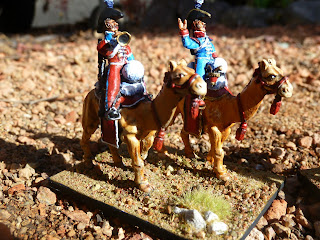Well I finished this eclectic little group of camel-mounted Froggies and am quite pleased with the result. They were hanging around for ages half done and I decided on impulse to do something a bit different and the choice fell between my WW1 Belgian Minerva armoured car and the French Camel Corps or Regiment des Dromadaires mounted command group. I did some more work on the Minerva but in the end couldn't resist the exotic French cameleers. They certainly were a colourful lot.
The most exotic unit of the French
Armee d'Orient, the Camel Corps was first raised in April 1799 while Desaix was given the Mission Impossible task of pursuing Murad Bey and the remaining Mamelukes up the Nile valley all the way to the Cataracts and even into what is present day Sudan with an infantry force supported by a small gunboat flotilla.

Desaix' campaign was launched from Giza at the end of August 1798 with less than 3,000 infantry and two guns. Some of his infantry were camel mounted but there were unlikely to be more than a few squadrons i.e. 2-300 men, who acted as a scouting force in the absence of cavalry. He was reinforced in January 1799 with 1,000 cavalry but at the time at Samhud (over 300 miles south of Giza & the largest engagement of the campaign) still faced 5,000 foot, 2,000 'Meccans" (think of an ancient version of Taliban fanatics!) 7,000 Arab horse as well as 2,000 Mamelukes! In nine months Desaix had marched over 5,000 miles and cleared the Nile of the Mamelukes and their allies, completely defeating them. It was an astounding feat of arms made with a totally inadequate and hopelessly outnumbered force that nevertheless succeeded in hounding the Mameluke threat virtually out of existence. If you want to read about it I recommend Strahan's excellent 'Napoleon In Egypt' (see one of my previous posts on it) and equally US historian J. Christopher Herold's 'Bonaparte In Egypt' - perhaps the best reference on the Egyptian campaign.

Once occupied, the French found that maintaining a military presence over such a vast area could not be done with precious few cavalry (which were soon needed by Napoleon for the Syrian campaign anyway) and isolated infantry posts. After loosing one or two and having several hundred men slaughtered they realised that a mobile force was needed to police the huge distances involved and the best way to do it was by mounting a sufficient force on camels.

Due to the general initial chronic shortage of cavalry and horses, small cavalry units had been mounted on camels after the Battle of the Pyramids but it wasn't until April 1799 that Napoleon ordered the formation of a regiment. The men were drawn from grenadier companies and amalgamated with Desaix' camel mounted infantry, ultimately numbering around 700 men in three squadrons with a company on foot. The regiment acted like a desert dragoon force - so essentially mounted infantry - which explains why they quickly abandoned the idea of putting trained cavalrymen on camels!
According to my precious copy of the old Blanford's "Uniforms of the French Revolutionary Wars', the uniform was all over the place - and quite complex. Some wore this, some wore that and at different times as French uniform supplies were initially chaotic after they quickly abandoned their heavy wool jackets for anything lighter! The only consistency was the sky blue with bright red facings.
As can be seen with two of my figures, an early experiment was the two-seater pannier arrangement which was eventually abandoned for the more practical single seat. As one came with what appeared to be an officer figure seated behind the turbaned trooper, I made another from Victrix and Perry plastic bits and bobs.
The regiment carried lances amongst a wide variety of weapons but these too were abandoned for the more useful infantry muskets. According to the Blandford through attrition by March 1800 they only numbered one squadron of 250, supported by a company of about 100 men on foot; the regiment disbanded when the French left Egypt in 1801.
Personally I would have liked to collect the entire
Armee d'Orient but I've seen few figures I like and few here collect the same period or more importantly, their opponents in the campaign - the huge varieties of Arabs from armed peasant
felaheen to horsemen, Saudi fanatics, Albanian and even Greek mercenaries and of course, the magnificently attired and armed-to-the-teeth Mamelukes. Oh, and not forgetting the Brits who helped kick Napoleon out of Syria and eventually the French out of Egypt. Perhaps one day I will collect them all but for the moment I have more Austrians to paint!
 |
| Au Revoir mes Amies from the Regiment des Dromadaires of the Armee d'Orient! |












































